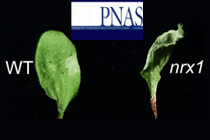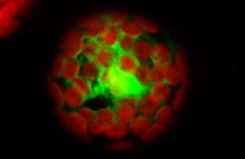News
Enzyme discovered that protects cellular anti-oxidants from becoming damaged
 Edinburgh, 19 July 2017 - The Spoel Research Group publishes a new article in PNAS describing the discovery of an enzyme that protects cellular antioxidants from becoming damaged. This finding has potential wide-ranging implications from agricultural to biomedical healthy ageing research.
Edinburgh, 19 July 2017 - The Spoel Research Group publishes a new article in PNAS describing the discovery of an enzyme that protects cellular antioxidants from becoming damaged. This finding has potential wide-ranging implications from agricultural to biomedical healthy ageing research.
Cellular accumulation of reactive oxygen species (ROS) such as hydrogen peroxide is associated with stress responses as well as ageing. The reactive nature of ROS marks these molecules as a serious threat to cell integrity and is therefore of great interest to both agriculture and medicine.
Cells deploy numerous antioxidant enzymes that detoxify ROS to protect them from ROS-induced damage to proteins. While the importance of antioxidant enzymes is well understood, how these proteins avoid becoming damaged in the hostile, ROS-rich environments they function in remains unknown.
In a new PNAS publication the Spoel Research Group shows that in plants cells the oxidoreductase, Nucleoredoxin 1 (NRX1), protects antioxidant enzymes such as catalase from ROS-induced oxidation. Importantly, this protective effect of NRX1 boosted the hydrogen peroxide detoxification capacity of catalase, thereby protecting the plant cell from oxidative stress. Compared to wild type (WT), mutant nrx1 plants are more susceptible to substrances that trigger oxidative stress. Thus, NRX1 is potentially an important target for agricultural innovations and advances in biomedical research into healthy aging.
Listen to Steven Spoel discussing these findings on the GARNet YouTube channel:
Links:
Read the Open Access publication from our library
Other News
BBSRC Discovery Fellowship awarded to Lucas Frungillo
Cellular trash bins show a surprising activity that controls plant immunity
Brexit "no-deal" is a bad deal for science
GARNet report on plant science funding
Report published on GARNet-SEB meeting
Cell Scientiest to Watch: Steven Spoel







